英语专业语用学试卷
大学英语语用学试题
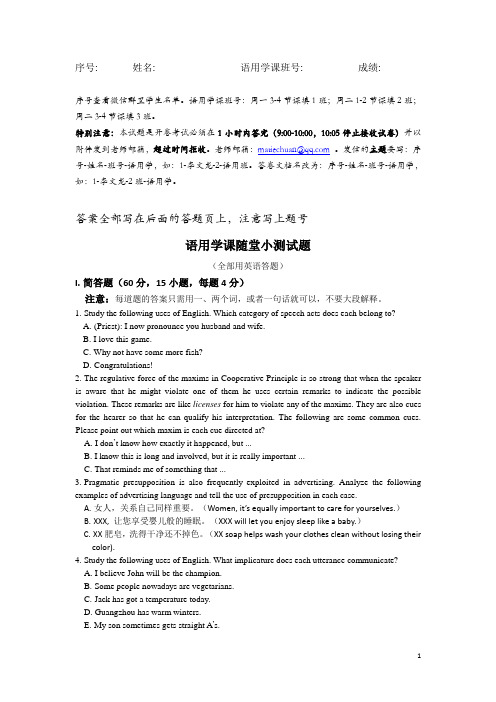
序号: 姓名: 语用学课班号: 成绩:序号查看微信群里学生名单。
语用学课班号:周一3-4节课填1班;周二1-2节课填2班;周二3-4节课填3班。
特别注意:本试题是开卷考试必须在1小时内答完(9:00-10:00,10:05停止接收试卷)并以附件发到老师邮箱,超过时间拒收。
老师邮箱:。
发信的主题要写:序号-姓名-班号-语用学,如:1-李文龙-2-语用班。
答卷文档名改为:序号-姓名-班号-语用学,如:1-李文龙-2班-语用学。
答案全部写在后面的答题页上,注意写上题号语用学课随堂小测试题(全部用英语答题)I.简答题(60分,15小题,每题4分)注意:每道题的答案只需用一、两个词,或者一句话就可以,不要大段解释。
1.Study the following uses of English. Which category of speech acts does each belong to?A.(Priest): I now pronounce you husband and wife.B.I love this game.C.Why not have some more fish?D.Congratulations!2.The regulative force of the maxims in Cooperative Principle is so strong that when the speaker is aware that he might violate one of them he uses certain remarks to indicate the possible violation. These remarks are like licenses for him to violate any of the maxims. They are also cues for the hearer so that he can qualify his interpretation. The following are some common cues. Please point out which maxim is each cue directed at?A.I don’t know how exactly it happened, but ...B.I know this is long and involved, but it is really important ...C.That reminds me of something that ...3.Pragmatic presupposition is also frequently exploited in advertising. Analyze the following examples of advertising language and tell the use of presupposition in each case.A.女人,关系自己同样重要。
语用学——精选推荐
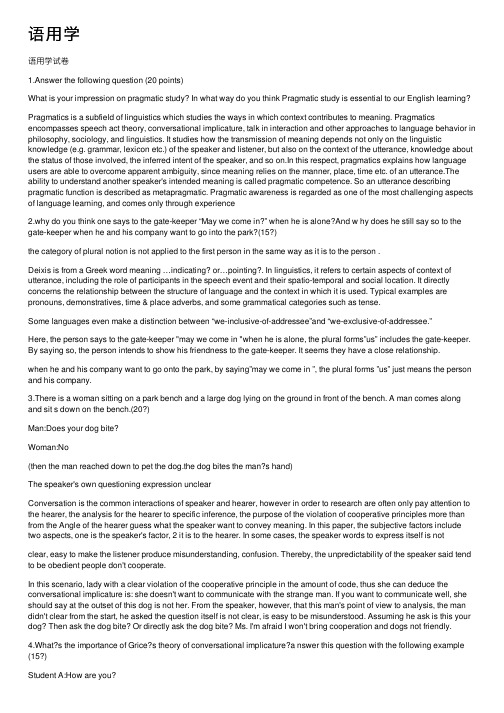
语⽤学语⽤学试卷1.Answer the following question (20 points)What is your impression on pragmatic study? In what way do you think Pragmatic study is essential to our English learning? Pragmatics is a subfield of linguistics which studies the ways in which context contributes to meaning. Pragmatics encompasses speech act theory, conversational implicature, talk in interaction and other approaches to language behavior in philosophy, sociology, and linguistics. It studies how the transmission of meaning depends not only on the linguistic knowledge (e.g. grammar, lexicon etc.) of the speaker and listener, but also on the context of the utterance, knowledge about the status of those involved, the inferred intent of the speaker, and so on.In this respect, pragmatics explains how language users are able to overcome apparent ambiguity, since meaning relies on the manner, place, time etc. of an utterance.The ability to understand another speaker's intended meaning is called pragmatic competence. So an utterance describing pragmatic function is described as metapragmatic. Pragmatic awareness is regarded as one of the most challenging aspects of language learning, and comes only through experience2.why do you think one says to the gate-keeper “May we come in?” when he is alone?And w hy does he still say so to the gate-keeper when he and his company want to go into the park?(15?)the category of plural notion is not applied to the first person in the same way as it is to the person .Deixis is from a Greek word meaning …indicating? or…pointing?. In linguistics, it refers to certain aspects of context of utterance, including the role of participants in the speech event and their spatio-temporal and social location. It directly concerns the relationship between the structure of language and the context in which it is used. Typical examples are pronouns, demonstratives, time & place adverbs, and some grammatical categories such as tense.Some languages even make a distinction between “we-inclusive-of-addressee”and “we-exclusive-of-addressee.”Here, the person says to the gate-keeper "may we come in "when he is alone, the plural forms”us” includes the gate-keeper. By saying so, the person intends to show his friendness to the gate-keeper. It seems they have a close relationship.when he and his company want to go onto the park, by saying”may we come in ”, the plural forms ”us” just means the person and his company.3.There is a woman sitting on a park bench and a large dog lying on the ground in front of the bench. A man comes along and sit s down on the bench.(20?)Man:Does your dog bite?Woman:No(then the man reached down to pet the dog.the dog bites the man?s hand)The speaker's own questioning expression unclearConversation is the common interactions of speaker and hearer, however in order to research are often only pay attention to the hearer, the analysis for the hearer to specific inference, the purpose of the violation of cooperative principles more than from the Angle of the hearer guess what the speaker want to convey meaning. In this paper, the subjective factors include two aspects, one is the speaker's factor, 2 it is to the hearer. In some cases, the speaker words to express itself is not clear, easy to make the listener produce misunderstanding, confusion. Thereby, the unpredictability of the speaker said tend to be obedient people don't cooperate.In this scenario, lady with a clear violation of the cooperative principle in the amount of code, thus she can deduce the conversational implicature is: she doesn't want to communicate with the strange man. If you want to communicate well, she should say at the outset of this dog is not her. From the speaker, however, that this man's point of view to analysis, the man didn't clear from the start, he asked the question itself is not clear, is easy to be misunderstood. Assuming he ask is this your dog? Then ask the dog bite? Or directly ask the dog bite? Ms. I'm afraid I won't bring cooperation and dogs not friendly.4.What?s the importance of Grice?s theory of conversational implicature?a nswer this question with the following example (15?)Student A:How are you?Student B:I?m dead.The importance of the theory of conversational implicature in pragmatics is due to various sources or contributions.1.the theory of conversational implicature may provide come significant function explanation for linguistic facts.2.it provides some explicit account of how it is possible to mean more than what is actually “said”, or more than what is literally expressed.3.it may help to simplify the content of semantic descriptions.4.it is essential if various basic facts about language are to be accounted for properly.5. it may offer an insight into the rhetorical use of language.The Cooperative Principle has four categories of maxims as follows:1. Quantity2.Quality3.Relation4.MannerIt is important to recognize these maxims as unstated assumptions we have in conversations. In this case, it violates the Quality of CP. Quality: Try to make your contribution one that is true.(1) Do not say what you believe to be false.(2) Do not say that for which you lack adequate evidence.We can see the sentence “I?m dead” is not true, so it violates the maxim of quality in CP and products implicature.5.Xiao:(look around)(20’)Grocer:⽼师吃什么?(what would you like to have,teacher?)Xiao:西⽠多少钱⼀⽄?(How much is water melon?)Grocer:⼀块⼆(one yuan and twenty)Xiao:⼀块⼆?很贵的(one yuan and twenty?very expensive)Grocer:哦,我们进来就⼀块⼀,⼀天挣不了⼏个钱,你要我给你便宜⼀⽑Grocer:好,来⼀个。
英语专业(语言学)历年真题试卷汇编13
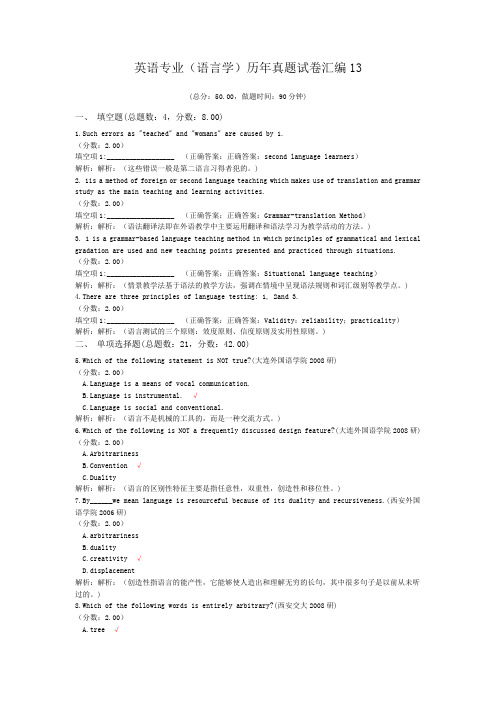
英语专业(语言学)历年真题试卷汇编13(总分:50.00,做题时间:90分钟)一、填空题(总题数:4,分数:8.00)1.Such errors as "teached" and "womans" are caused by 1.(分数:2.00)填空项1:__________________ (正确答案:正确答案:second language learners)解析:解析:(这些错误一般是第二语言习得者犯的。
)2. 1is a method of foreign or second language teaching which makes use of translation and grammar study as the main teaching and learning activities.(分数:2.00)填空项1:__________________ (正确答案:正确答案:Grammar-translation Method)解析:解析:(语法翻译法即在外语教学中主要运用翻译和语法学习为教学活动的方法。
)3. 1 is a grammar-based language teaching method in which principles of grammatical and lexical gradation are used and new teaching points presented and practiced through situations.(分数:2.00)填空项1:__________________ (正确答案:正确答案:Situational language teaching)解析:解析:(情景教学法基于语法的教学方法,强调在情境中呈现语法规则和词汇级别等教学点。
) 4.There are three principles of language testing: 1, 2and 3.(分数:2.00)填空项1:__________________ (正确答案:正确答案:Validity:reliability;practicality)解析:解析:(语言测试的三个原则:效度原则、信度原则及实用性原则。
英语专业(语言学)历年真题试卷汇编5

英语专业(语⾔学)历年真题试卷汇编5英语专业(语⾔学)历年真题试卷汇编5(总分:44.00,做题时间:90分钟)⼀、简答题(总题数:16,分数:44.00)Please disambiguate the following 5 sentences, using the tree-diagram, or any other means that you think is appropriate.(北京交通⼤学2007研)(分数:10.00)(1).Jane showed her baby pictures.(分数:2.00)__________________________________________________________________________________________正确答案:()解析:(2).The old man is drinking in the air.(分数:2.00)__________________________________________________________________________________________ 正确答案:(正确答案:a.(VP drinking in)(NP the air)b.(VP drinking(PP in the air)))解析:(3).We need more realistic officials to handle the economy.(分数:2.00)__________________________________________________________________________________________正确答案:()解析:(4).We are sweeping the ground cigarettes on the street.(分数:2.00)__________________________________________________________________________________________ 正确答案:(正确答案:a.(VP sweeping(NP the ground cigarettes(PP on the street)))b.(vp sweeping(NP the ground cigarettes)(pp on the street)))解析:(5).Tom exchanged the money and fell around the corner.(分数:2.00)__________________________________________________________________________________________ 正确答案:(正确答案:a.(Vp exchanged the money)and(Vp fell around the corner)b.(VP exchanged the money and fell)(PP around the corner))解析:1.What is Halliday"s idea on the relationship between the functions performed by language and its structures?(分数:2.00)__________________________________________________________________________________________ 正确答案:(正确答案:In Halliday"s point of view, there are three general functions of language: ideational(which is subdivided into experiential and logical), interpersonal and textual. And they are related to the three grammatical systems; transitivity, mood and theme. Specifically, the ideational function is realized as the transitivity system in the clause as a representation of experience, in which there are six processes; material, mental, relational, behavioral, verbal and existential. Actor, the so-called logical subject, is an important participant in the material process. The interpersonal function is realized as the mood system in the clause as an exchange, which is divided into the two major parts of Mood and Reside. And Subject is one of the two parts of Mood, the other part being the finite verbal operator. The textual function is realized as the thematic structure of the clause as a message. The two main constituents here are theme and rheme, the former being the point of departure of the message, or the concern of the clause, while the latter is the part in which the theme is developed.)解析:2.What are deep and surface structures?(分数:2.00)__________________________________________________________________________________________ 正确答案:(正确答案:Deep structure is a central theoretical term in generative grammar opposed to surface structure. It is the abstract syntactic representation of a sentence—an underlying level of structural organization which specific all the factors governing the way the sentence should be interpreted. Surface structure is a central theoretical term in generative grammar, opposed to deep structure. It is the final stage in the syntactic representation of a sentence, which provides the input to the phonological component of the grammar, and which thus most closely corresponds to the structure we articulate and hear.)解析:3.In the following three sentences, the particle "up" stays in different positions, i. e. immediately after the verb; in between the noun phrase and the relative clause; and at the end of the sentence. Can you formulate a syntactic rule to explain the position changes of the particle?(1)She stood up the man who offered her a diamond.(2)She stood the man up who offered her a diamond.(3)She stood the man who offered her a diamond up.(南开⼤学2010研)(分数:2.00)__________________________________________________________________________________________ 正确答案:(正确答案:According to chomsky"s Generative and Functional Grammar, there is an underlying representation for any sentence. Then the underlying form is transformed into the surface form through some transformational rules. The same underlyilyng form may result in different surface representation by undertaking different operation. Sometimes, the same surface form is likely to be transformed from different deep structure because of various movement. "Stand sb. up" means that sb. fails to show up in a date though he has promised to appear, and let the other wait for him in vain. The underlying form of the above three sentences have the same underlying form, that is " She stood the man up who offered her a diamond". The reason why they finally have the different form is that they have undertaken different operation. Because "up" is an adjunct in the three sentences, it is more convenient to put it since it will not change the property of the sentence. Therefore, finally we get the three kinds of surface forms. Sentence one, "up" is moved upward to the front of the man for the purpose of banlancing the sentence. Sentence two, "up" is moved upwards to the front of the attrubutive clause to the front of the attributive clause in order to achieve coherence. And the last sentence is the underlying form. Consequently, we can say that it is very flexible to position the adjunct in a sentence for various purposes.)解析:4.What is conceptual meaning? Try to distinguish it from any other types of meaning classified by Leech?(北⼆外2008研)(分数:2.00)__________________________________________________________________________________________ 正确答案:(正确答案:According to Leech, conceptual meaning refers to the logical, cognitive or denotive content of the meaning of a word. It is concerned with the relationship between a word and the thing it refers to. Conceptual meaning overlaps to a large extent with the notion of reference. But the term "connotative" is used in daily conversation, refers to some additional, especially emotive, meaning. This type of meaning and the following four types, namely, social meaning, affective meaning , reflected meaning and collocative meaning, are collectively known as associative meaning in the sense that an elementary associationist theory of mental connections is enough to explain their use. The last type, thematic meaning, is more peripheral since it is only determined by the order of the words in a sentence and the different prominence they each receive.)5.Explain the notion of hyponym.(北⼆外2008研)(分数:2.00)__________________________________________________________________________________________ 正确答案:(正确答案:A term which is subordinate to another in that its extension is contained in the extension of another, e. g. "lion" or "tiger" is a hyponym of "animal".)解析:6.How would you describe the oddness of the following sentences, using semantic features?(浙江⼤学2004研)(a)The television drank my water.(b)His dog writes poetry.(分数:2.00)__________________________________________________________________________________________ 正确答案:(正确答案:(a)The verb drink represents a behavior of the animate beings, therefore, it is required that the subject of this verb should have a semantic feature as(+ ANIMATE), however, the word television, which is in position of subject, has an opposite feature:(- ANIMATE). That"s why such a collocation results in oddness. (b)The action of writing poetry is normally one which only human beings could do, therefore, the subject is required to have a semantic feature as(+ HUMAN); however, the word dog in the subject position is featured as(-HUMAN). Therefore, the sentence is odd.)解析:What is one obvious presupposition of the speaker who says:(分数:4.00)(1).Where did he buy the beer?(分数:2.00)__________________________________________________________________________________________ 正确答案:(正确答案:One obvious presupposition of the sentence "Where did he buy the beer" should be " He has some beer".)解析:(2).Your watch is broken.(上海交⼤2006研)(分数:2.00)__________________________________________________________________________________________ 正确答案:(正确答案:One obvious presupposition of the sentence "Your watch is broken" should be "You have a watch".)解析:Tell the sense relation between a and b in each pair:(北⼆外2007研)(分数:4.00)(1).a. He no longer likes coffee. b. He liked coffee.(分数:2.00)__________________________________________________________________________________________ 正确答案:(正确答案:a entails b)解析:(2).a. Mary is working in China. b. Mary is working in Beijing.(分数:2.00)__________________________________________________________________________________________ 正确答案:(正确答案:b presupposes a)解析:7.In what way is componential analysis similar to the analysis of phonemes into distinctive features?(分数:2.00)__________________________________________________________________________________________ 正确答案:(正确答案:In the light of componential analysis, the meaning of a word consists of a number of distinctive meaning features; the analysis breaks down the meaning of the word into these features, and it is these different features that distinguish word meaning similarly. A phoneme is considered a collection of distinctive sound features; a phoneme can be broken down into these distinctive sound features and it is these sound features that distinguish different sounds.)8.Are utterances, sentences, and propositions the same?(分数:2.00)__________________________________________________________________________________________正确答案:(正确答案:No. These three terms are used to describe different levels of language. The most concrete is utterance which is created by speaking(or writing)a piece of language. Sentences, on the other hand, are abstract grammatical elements obtained from utterances. For example, an utterance has a tone, or perhaps some accent due to regional or social variation, and phonetic details which identify individual speakers, etc. But at the level of sentence, these kinds of information are ignored. Propositions are the result of a further abstraction of sentences, which are descriptions of states of affairs and which some writers see as a basic element of sentence meaning. For example , the two sentences " Caesar invaded Gaul" and " Gaul was invaded by Caesar" hold the same preposition.)解析:9.Do you think there are true synonyms in English? Why?(厦门⼤学2010研)(分数:2.00)__________________________________________________________________________________________正确答案:(正确答案:Synonymy is the technical name for the sameness relation. It is used to mean sameness or close similarity of meaning. Total synonymy is rare. The so-called synonyms are all context dependent. They all differ in one way or another. When you consider the meaning of a word, you need to consider both its denotation and its connotation. The denotation is the primary, literal meaning of a word. The connotation is the suggested or implied meaning of a word. Connotations usually come from experience or associations. Seeing a word used repeatedly in certain contexts gives the word a different color than it gets in the dictionary. There are no real synonyms, because two or more words named synonyms are expected without exception to differ from one another in one of the following aspects: (1)in shade of meaning(finish, complete, close, conclude); (2)in stylistic meaning(father, dad); (3)in emotive(or affective)meaning(smart, crafty); (4)in range of use or collocative meaning(accuse, charge);(5)in British and American English usages(autumn, fall). For example, they may differ in style. In the context "Little Tom______a toy bear" , here buy is more appropriate than purchase. Because purchase is more formal than buy.)解析:10.What are the major concerns of pragmatics?(⼈⼤2006研)(分数:2.00)__________________________________________________________________________________________正确答案:(正确答案:Pragmatics is the study of the language in use. It is mainly about how speakers use language appropriately and effectively in accordance with a given context. It is concerned with the study of meaning as communicated by a speaker(or writer)and interpreted by a listener(or reader). It has more to do with participants of communication and context in which communication takes place. Hence the study of speaker meaning, that of contextual meaning, of what is unsaid but communicated.)解析:11.How would you describe this short exchange in terms of the ardors performed by the speakers?(浙江⼤学2005研)Motorist: My car needs new exhaust system. Mechanic: I"ll be busy with this other car all day.(分数:2.00)__________________________________________________________________________________________正确答案:(正确答案:In the motorist"s utterance, there are two types of speech acts performed, namely representative and directive, and as to the latter one, it is recognized as an indirectspeech act, which is performed through the performance of the former one. Thus, by stating that his car needs new exhaust system, the motorist has in fact asked the mechanic to equip a new exhaust system for him. Similarly, in the mechanic"s utterance, there are two types of speech acts performed; one is representative, the other commissive. The commissive speech act in fact is an indirect one since it is recognized through the performance of representative action. That is to say, by stating that he will be busy with another car all day, the mechanic has in fact told the motorist that he could not repair his car right away.)解析:12.Conversational implicature is comparable to illocutionary force in speech act theory in that they are both concerned with the contextual side of meaning, or " ⾔外之意" in Chinese.(中⼭⼤学2005研)(分数:2.00)__________________________________________________________________________________________ 正确答案:(正确答案:We may summarize conversational implicature as a type of implied meaning. It could be inferred only by the dependence on the context of the utterance and shared knowledge between the speaker and listener. Illocutionary force, on other hand, refers to speaker"s meaning, contextual meaning , or extra meaning, that is, the meaning the speaker wants to convey in a specific context. By an illocutionary force, we can say "What does he mean by saying that?" In this sense, implica-ture is comparable to illocutionary force in speech act theory in that they are both concerned with the contextual side of meaning, or "⾔外之意" in Chinese.)解析:13.Decide which maxim of the cooperative principle has been flouted in the following utterances and what implicature can be drawn.(厦门⼤学2006研)(1)A: Can you tell me the secret? B: But John is there.(2)A: Let"s go to the movies. B: I"ll bring the Kleenex.(3)A: Would you drive a Mercedes? B: I wouldn"t drive ANY expensive car.(分数:2.00)__________________________________________________________________________________________ 正确答案:(正确答案:In the exchanges, the maxim of relation has been flouted. As to instance(1), A will assume that if B is cooperative, his reply must be relevant in a different sense: I will not talk about my secret now because I do not want to let John know. In(2), the answer of B seems irrelevant to A"s utterance. By doing so, A will likely derive the implicature that B has accepted his suggestion , and is going to get prepared. In(3), by violating the maxim of relation, B intends to implicate that Mercedes is an expensive car and he would not drive a Mercedes.)解析:。
最新英语(教)专业语言与应用语言学试题、答案及评分标准

语言与应用语言学试题期末考试英语(教)专业语言与应用语言学试题注意事项一、将你的学号、姓名及分校(工作站)名称填写在答题纸的规定栏内。
考试结束后,把试卷和答题纸放在桌上。
试卷和答题纸均不得带出考场。
二、仔细阅读题目的说明,并按题目要求答题。
答案一定要写在答题纸指定的位置上?写在试卷上的答案无效。
三、用蓝、黑圆珠笔或钢笔答题,使用铅笔答题无效。
Information for the examinees:This examination consists of Four sections. They are:Section I: Content Awareness of the Course (30 points, 20 minutes)Section II: General Principles of Language and Linguistics (30 points, 25 minutes)Section III: Some Specific Aspects of Language and Linguistics (20 points, 35 minutes)Section IV: Analysis and Application (20 points, 40 minutes)The total marks for this examination are 100 points. Time allowed for completing thisexamination is 2 hours.You must write all your answers on the Answer Sheet.Section I: Content Awareness of the Course 30 pointsI. Choose the best answer to complete the following statements. Write your answers on theAnswer Sheet. (10 points, 1 point for each item)1. "Historical linguistics" seeks to provide scientific evidence __A. of the reasons for human speechB. of human habitation in AfricaC. why there are many world languagesD. concerning the origins of speech2. Which of the following does NOT have something to do with the production of speech sounds?A. Organic analysisB. Linguistic analysisC. Acoustic analysisD. Phonetic analysis3. In determining the symbolic nature of language humansA. examine Braille and signsB. examine the media and signsC. examine the language of the mediaD. examine the language itself4. The aims of Unit 4 are to understand that language functions in the worldA. through the use of naming devices and educationB. by people experiencing abstractions in educationC. based on experience, abstraction and symbolismD. through symbolic and abstract experiences5. The aim of Unit 5 is for students to understand that speech actsA. need to be defined precisely through oral actionsB. need to be terminated under appropriate circumstancesC. need to be defined, analysed and comprehendedD. need to be analysed by definition and example:6. Generally speaking, 脸 and 面子 is:A. more important for teenage girls than boysB. something teenagers don"t worry aboutC. not the same for adults as for teenagersD. the same for adults as for teenagers7. In face to face talk people"s interactive behaviour is based uponA. Principles of Desire and DecisionsB. The Principle of Mutual DesirabilityC. Principles of Decision MakingD. The Principle of Mutuality8. If an 9verseas Chinese is called monolingual this meansA. the person speaks primarily English but also speaks Chinese at homeB. the person has had to choose between speaking another language or ChineseC. the choice of speaking a language has been limited to one of two languagesD. the person has chosen to speak Chinese in public and at home9. According to the course our brain is divided into two hemispheres. Language functionsaremainly located in theA. left hemisphereB. lower hemisphereC. right hemisphereD. upper hemisphere10. The story of Genie in Unit 9 seems to highlight the language hypothesis of~A. Eric LennehergB. Antonio FrancsC. Jean-Marc-Gaspard ItarD. Sigmund Freud11. Choose those words or phrases that best complete the following sentences. Write youranswers on the Answer Sheet. Note that there are more words or phrases than necessary.(20 points, 2 points for each item)A. syntagmaticB. BrailleC. self-orientedD. languageE. homo sapiensF. homo habilisG. cognitiveH. ideographicI. other-orientedJ. paradigmaticK. classificationL. pictographicA. Professor Guide (in Unit 1) makes the major point that the possession of 11 ~ by12 bas contributed to civilized and meaningful living.B. The British manual alphabet and 13 are mediums of language representation .C. Chinese writing is 14 , rather than 15D. When we name things it involves an act of 16 . This act is not neutral thereforethere are social as well as 17 repercussions.E. When asking the names of people, Chinese people appear to be more 18compared to British people who seem to be very 19F. When words enter into sequential relation, it is called 20 relation.Section II: General Principles of Language and Linguistics 30 pointsIII. Decide if the following statements are True or False according to what you"ve learned from the course book. (10 points, 1 point for each item)21. The linguistic theory called " transformational-generative grammar" focuses on therelationship between the language and the brain.22. The lips are a part of the vocal tract.23. Signs and icons are, in reality, the same thing.24. Humans are not good at abstraction.25. Ill0cutionary acts can be performed both directly and indirectly.26. Some dialects or accents are related to social or economic status in China.27. The Chinese characters 1--~-,:~ and i are examples of written norms.28. Non-verbal signals are, generally, easily interpreted.29. Status and regional identity can be linked to dialect.30. The "classical" view of the terms ,~,~, and .1~,~, was that because the radical ,I~"was usedit connected the heart to the concept of thinking.IV. Read the questions in Column A and choose the right one from Column B to answer eachof them. Write the corresponding letter on the Answer Sheet. There is ONLY one answer foreach question. (20 points, 2 points for each item)Column AColumn B31. "Hi! I"m Irene."What speech act is the speaker performing?32. In Chinese, instead of saying "拉屎", we use "方便一下" or "去一号". What are these expressions known as?33. The word "rose" is related to the thing it stands for by the mind that understands it.What is the name given to this relationship?34. When words take place in sequence, what is this called?35. [A] "You must come and have dinner with us. "[B] "Sorry, I"ve got something to do."In the above exchange; What maxim of English politeness does the speaker observe or violate?36. What name do we give to the process -- from an immediate experience of a real thingto naming it and categorizing it?37. What is the term used hy Hayakawa that denies or ignores the existence of any middleground between two opposing forces?38. "Coo-..coo.."could ""you "" you "" te...tell me the--, way to the p--.p ."-post of{ice p ." p[ "" please?": What type of program me might be able to correct this person" s language problem?39. (A Chinese student at a bus stop in London for the first time--"Do you mind! Please join the queue like the rest of us."-- "Must I?"The student did not know he has to queue for the bus. tie did not have any prior knowledge. Linguistically, what is this sort of knowledge called?40. A visiting Chinese scholar at Nottingham University in the U.K. remarked: 请我到office 来找我。
英语专业(语言学)历年真题试卷汇编2
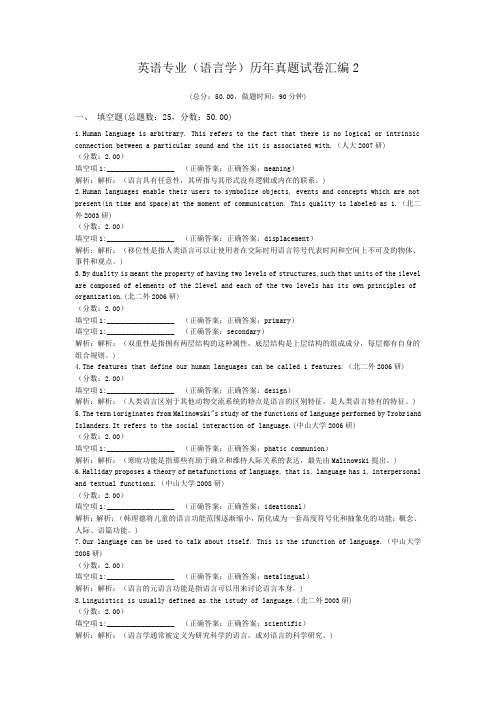
英语专业(语言学)历年真题试卷汇编2(总分:50.00,做题时间:90分钟)一、填空题(总题数:25,分数:50.00)1.Human language is arbitrary. This refers to the fact that there is no logical or intrinsic connection between a particular sound and the 1it is associated with.(人大2007研)(分数:2.00)填空项1:__________________ (正确答案:正确答案:meaning)解析:解析:(语言具有任意性,其所指与其形式没有逻辑或内在的联系。
)2.Human languages enable their users to symbolize objects, events and concepts which are not present(in time and space)at the moment of communication. This quality is labeled as 1.(北二外2003研)(分数:2.00)填空项1:__________________ (正确答案:正确答案:displacement)解析:解析:(移位性是指人类语言可以让使用者在交际时用语言符号代表时间和空间上不可及的物体、事件和观点。
)3.By duality is meant the property of having two levels of structures,such that units of the 1level are composed of elements of the 2level and each of the two levels has its own principles of organization.(北二外2006研)(分数:2.00)填空项1:__________________ (正确答案:正确答案:primary)填空项1:__________________ (正确答案:secondary)解析:解析:(双重性是指拥有两层结构的这种属性,底层结构是上层结构的组成成分,每层都有自身的组合规则。
英语专业(语言学)历年真题试卷汇编12

英语专业(语言学)历年真题试卷汇编12(总分:50.00,做题时间:90分钟)一、填空题(总题数:25,分数:50.00)1.Sentence meaning is the combination of the meanings of the component words and 1.(分数:2.00)填空项1:__________________ (正确答案:正确答案:the meaning of its structure)解析:解析:(句子的意义是由词汇意义与句子结构两者决定的。
)2.The hyponyms under the same superordinate are called 1.(分数:2.00)填空项1:__________________ (正确答案:正确答案:co一hyponyms)解析:解析:(同类中的成员叫做同下义词。
)3.A perlocutionary act is the act performed by or resulting from saying something; it is the 1 of, or the 2the utterance.(人大2004研)(分数:2.00)填空项1:__________________ (正确答案:正确答案:consequence; change brought about by)解析:4.When a teacher says "The exam this year is going to be really difficult" , the sentence would have an 1force.(清华2001研)(分数:2.00)填空项1:__________________ (正确答案:正确答案:illocutionary)解析:解析:(行事行为是表达说话人意图的行为,老师所说的话表明了让学生努力学习的意图。
大学语用学试卷
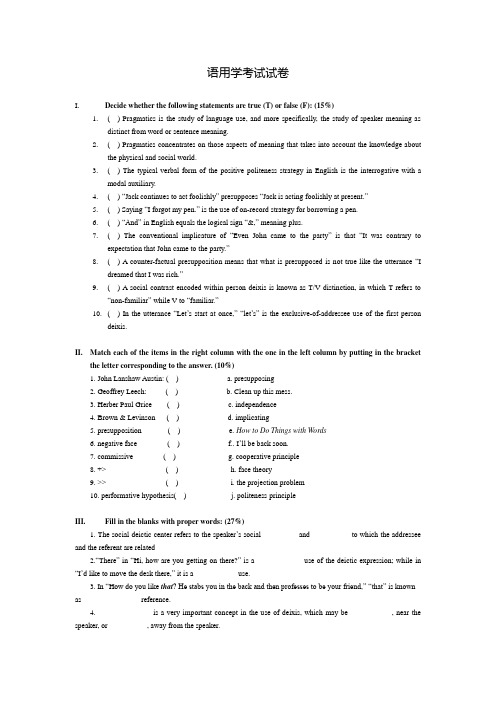
语用学考试试卷I.Decide whether the following statements are true (T) or false (F): (15%)1.( ) Pragmatics is the study of language use, and more specifically, the study of speaker meaning asdistinct from word or sentence meaning.2.( ) Pragmatics concentrates on those aspects of meaning that takes into account the knowledge aboutthe physical and social world.3.( ) The typical verbal form of the positive politeness strategy in English is the interrogative with amodal auxiliary.4.( ) “Jack continues to act foolishly” presupposes “Jack is acting foolishly at present.”5.( ) Saying “I forgot my pen.” is the use of on-record strategy for borrowing a pen.6.( ) “And” in English equals the logical sign “&,” meaning plus.7.( ) The conventional implicature of “Even John came to the party”is that “It was contrary toexpectation that John came to the party.”8.( ) A counter-factual presupposition means that what is presupposed is not true like the utterance “Idreamed that I was rich.”9.( ) A social contrast encoded within person deixis is known as T/V distinction, in which T refers to“non-familiar” while V to “familiar.”10.( ) In the utterance “Let’s start at once,”“let’s” is the exclusive-of-addressee use of the first persondeixis.II. Match each of the items in the right column with the one in the left column by putting in the bracket the letter corresponding to the answer. (10%)1. John Lanshaw Austin: ( ) a. presupposing2. Geoffrey Leech: ( ) b. Clean up this mess.3. Herber Paul Grice ( ) c. independence4. Brown & Levinson ( ) d. implicating5. presupposition ( ) e. How to Do Things with Words6. negative face ( ) f.. I’ll be back soon.7. commissive ( ) g. cooperative principle8. +> ( ) h. face theory9. >> ( ) i. the projection problem10. performative hypothesis( ) j. politeness principleIII.Fill in the blanks with proper words: (27%)1. The social deictic center refers to the speaker’s social _________ and __________ to which the addressee and the referent are related2.“There” in “Hi, how are you getting on there?” is a ____________ use of the deictic expression; while in “I’d like to move the desk there,” it is a ___________ use.3. In “How do you like that? He stabs you in the back and then professes to be your friend,”“that” is known as _______________ reference.4. ______________ is a very important concept in the use of deixis, which may be ___________, near the speaker, or __________, away from the speaker.5. A conversational implicature is generated when one or more of the maxims of cooperative principle is ______________ with the hearer’s ______________.6. The hyperbole in “She’s the most beautiful girl in the world” can be interpreted as being produced through the violation of the maxim of ______________.7. The blessing expression “Happy new year!” is an example of __________ deixis.8. According to politeness theory, the more ____________ the linguistic form is, the higher degree of politeness it has when used to make a request.9. The locutionary act of an utterance is concerned with the basic act of its ____________ form; while the illocutionary act with its ____________. and the perlocutionary act with its_____________.10. The final phrase “I guess”in “It will clear up tomorrow, I guess.”is called a __________ device that exemplifies the speaker’s observation of the maxim of ___________.11. In saying “I don’t know if this is important, but some of the files are missing,” the speaker is observing the maxim of ________________.12. According to Halliday, language plays three functions, namely ______________ function, _____________ function, and ______________ function,13. A simple utterance like “I’m tired” may have different pragmatic meanings in different contexts. Write out the sentence semantic meaning,two of its possible pragmatic meanings and the corresponding contexts they are in.the semantic meaning: ____________________________________________pragmatic meaning 1: _____________________________________________(the relevant context):_____________________________________________pragmatic meaning 2: _____________________________________________(the relevant context):_____________________________________________IV.Briefly answer TWO of the following questions (around 50-60 words for each) Write your answer on the other side of the paper. (Attention: Indicate your choices among the questions by writing their corresponding letters at the beginning of your answers.). (48%)a)It is strongly believed that background knowledge, to which culture is closely related culture, plays avery important role in communication. What implications do you think this belief has for interculturalcommunication and foreign/ second language teaching?b)In what way is deixis or speech act theory or conversational implicature theory or presuppositiontheory, an important aspect of pragmatic study? (Give at least one example to illustrate your discussion) (15%)c)One of the properties of politeness is gradation. Do you think the more polite an utterance is, the betterit is? Why (not)? (15%)d)Point out TWO of the five features of conversational implicature discussed in class and use examplesto illustrate the features.Answer KeyI. 1. T 2. T 3. F 4. F 5. F 6. F 7. T 8. F 9. F 10. FII. 1. e 2. j 3. g 4. h 5. I 6. c 7. f 8. d 9. a 10. bIII. 1. status, rank 2. symbolic, gestural 3.cataphoric 4. distance, proximal, distal5. violated, knowledge6. quality7. social8. indirect9. linguistic, force, effect10. hedging, quality 11. relation 12. interpersonal, ideational, textual 13. (omitted)IV. (omitted)。
英语专业(语言学)历年真题试卷汇编4
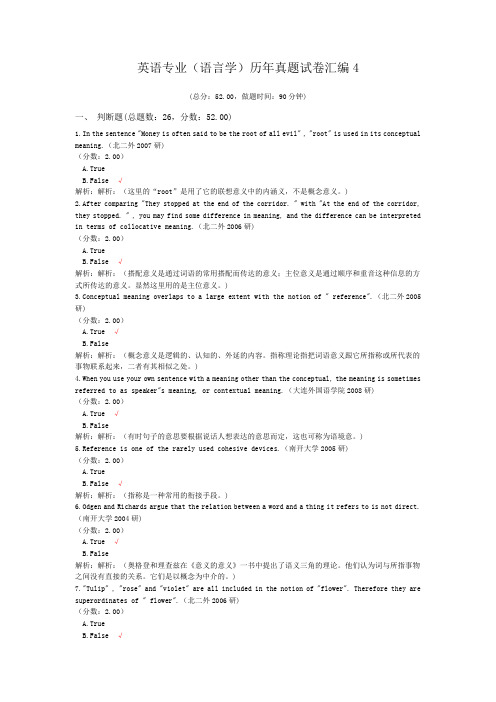
英语专业(语言学)历年真题试卷汇编4(总分:52.00,做题时间:90分钟)一、判断题(总题数:26,分数:52.00)1.In the sentence "Money is often said to be the root of all evil" , "root" is used in its conceptual meaning.(北二外2007研)(分数:2.00)A.TrueB.False √解析:解析:(这里的“root”是用了它的联想意义中的内涵义,不是概念意义。
)2.After comparing "They stopped at the end of the corridor. " with "At the end of the corridor, they stopped. " , you may find some difference in meaning, and the difference can be interpreted in terms of collocative meaning.(北二外2006研)(分数:2.00)A.TrueB.False √解析:解析:(搭配意义是通过词语的常用搭配而传达的意义;主位意义是通过顺序和重音这种信息的方式所传达的意义。
显然这里用的是主位意义。
)3.Conceptual meaning overlaps to a large extent with the notion of " reference".(北二外2005研)(分数:2.00)A.True √B.False解析:解析:(概念意义是逻辑的、认知的、外延的内容。
指称理论指把词语意义跟它所指称或所代表的事物联系起来,二者有其相似之处。
)4.When you use your own sentence with a meaning other than the conceptual, the meaning is sometimes referred to as speaker"s meaning, or contextual meaning.(大连外国语学院2008研)(分数:2.00)A.True √B.False解析:解析:(有时句子的意思要根据说话人想表达的意思而定,这也可称为语境意。
英语专业(语言学)历年真题试卷汇编15

英语专业(语言学)历年真题试卷汇编15(总分:52.00,做题时间:90分钟)一、简答题(总题数:26,分数:52.00)1.Do you think B is cooperative in the following dialogue? Support your argument with Cooperative Principle.(南开大学2004研)A: When is the bus coming?B: There has been an accident further up the road.(分数:2.00)__________________________________________________________________________________________正确答案:(正确答案:On the face of it, B violated the maxim of relation since he did not provide a direct answer to A"s question. But A would assume that B is cooperative in the conversation, and would try to explore the link between the seemingly irrelevant response to something relevant. Thus, A would interpret B"s utterance in such a way that because there had been as accident further up the road, it was quite possible that the road was blocked; in a consequence, the bus would not be able to come.)解析:2.Analyze the following dialogue with reference to Grice"s Cooperative Principle.(北二外2005研)A: Oh I like this popular song so much How about you?B: I often hear classical music, especially, the symphonies composed by Beethoven His Symphony No. 9 is my favorite.(分数:2.00)__________________________________________________________________________________________正确答案:(正确答案:B has obviously violated Maxim of Relation; A was asking B"s opinion about a particular popular song, but B"s response was actually about classical music. By such a violation, B probably wanted to imply that he did not like that popular song.)解析:3.In what ways do people cooperate in their conversations?(人大2006研)(分数:2.00)__________________________________________________________________________________________正确答案:(正确答案:In daily conversations people do not usually say things directly but tend to imply them, and according to Grice, they seem to observe willingly or unwillingly certain principle, which is called "cooperative principle" : "Make your conversational contribution such as is required, at the stage at which it occurs, by the accepted purpose or direction of the talk exchange in which you are engaged". Under this principle, there are four maxims, namely, Quantity, Quality, Relation, and Manner.)解析:4.What is sociolinguistics?(北航2008研)(分数:2.00)__________________________________________________________________________________________正确答案:(正确答案:Sociolinguistics is an umbrella term which covers a variety of different interests in language and society, including the social functions of language and the social characteristics of its users. It studies the characteristics of language varieties, the characteristics of their functions, and the characteristics of their speakers as these three constantly interact and change within a speech community.)解析:解析:(本题考查社会语言学的定义。
英语专业(语言学)历年真题试卷汇编6
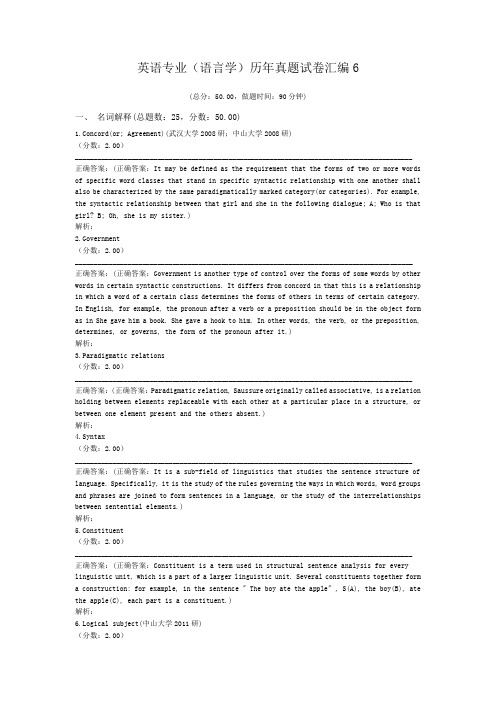
英语专业(语言学)历年真题试卷汇编6(总分:50.00,做题时间:90分钟)一、名词解释(总题数:25,分数:50.00)1.Concord(or; Agreement)(武汉大学2008研;中山大学2008研)(分数:2.00)__________________________________________________________________________________________ 正确答案:(正确答案:It may be defined as the requirement that the forms of two or more words of specific word classes that stand in specific syntactic relationship with one another shall also be characterized by the same paradigmatically marked category(or categories). For example, the syntactic relationship between that girl and she in the following dialogue; A; Who is that girl? B; Oh, she is my sister.)解析:ernment(分数:2.00)__________________________________________________________________________________________ 正确答案:(正确答案:Government is another type of control over the forms of some words by other words in certain syntactic constructions. It differs from concord in that this is a relationship in which a word of a certain class determines the forms of others in terms of certain category. In English, for example, the pronoun after a verb or a preposition should be in the object form as in She gave him a book. She gave a hook to him. In other words, the verb, or the preposition, determines, or governs, the form of the pronoun after it.)解析:3.Paradigmatic relations(分数:2.00)__________________________________________________________________________________________ 正确答案:(正确答案:Paradigmatic relation, Saussure originally called associative, is a relation holding between elements replaceable with each other at a particular place in a structure, or between one element present and the others absent.)解析:4.Syntax(分数:2.00)__________________________________________________________________________________________ 正确答案:(正确答案:It is a sub-field of linguistics that studies the sentence structure of language. Specifically, it is the study of the rules governing the ways in which words, word groups and phrases are joined to form sentences in a language, or the study of the interrelationships between sentential elements.)解析:5.Constituent(分数:2.00)__________________________________________________________________________________________ 正确答案:(正确答案:Constituent is a term used in structural sentence analysis for every linguistic unit, which is a part of a larger linguistic unit. Several constituents together form a construction: for example, in the sentence " The boy ate the apple" , S(A), the boy(B), ate the apple(C), each part is a constituent.)解析:6.Logical subject(中山大学2011研)(分数:2.00)__________________________________________________________________________________________ 正确答案:(正确答案:Logical subject is the subject of a sentence that expresses the actual agent of an expressed or implied action. In passive voice such as "John was bitten by a dog", we have two terms "grammatical subject" and "logical subject". Since the core object noun {John in this case)sits in the slot before the verb in the passive, it is called grammatical subject, for the original object noun phrase occupies the grammatical space before a verb, the space that a subject normally occupies; the core subject(A dog), now the object of a preposition(by a dog), is called the logical subject, since semantically the core subject still does what a subject normally does: it performs an action.)解析:7.Semantic Triangle(大连外国语学院2008研)(分数:2.00)__________________________________________________________________________________________ 正确答案:(正确答案:Ogden and Richards presented the classic "Semantic Triangle" as manifested in the following diagram , in which the " symbol" or " form" refers to the linguistic elements(word, sentence, etc.), the "referent" refers to the object in the world of experience, and "thought" or "reference" refers to concept or notion. According to this view, there is no direct link between symbol and referent, that is, between language and the world. The link is via thought, the concept)解析:8.Gradable antonym(人大2006研)(分数:2.00)__________________________________________________________________________________________ 正确答案:(正确答案:Gradable antonym. Gradable antonyms are antonyms that are gradable because there are often intermediate forms between the two members of a pair. For example, cold and warm constitute a pair of gradable antonyms.)解析:9.Semantic feature(四川大学2006研)(分数:2.00)__________________________________________________________________________________________ 正确答案:(正确答案:Semantic feature. The meaning of a word can be dissected into meaning components which are called semantic features. For example, the word "man" is analyzed as comprising the features of + HUAMN, + ADULT, + ANIMATE, +MALE.)解析:ponential analysis(浙江大学2005研;北航2008研)(分数:2.00)__________________________________________________________________________________________ 正确答案:(正确答案:Componential analysis. It refers to a semantic approach which defines the meaning of a lexical element in terms of semantic components, or semantic features. For example, the meaning of the word boy may be analyzed into three components: HUMAN, YOUNG and MALE.) 解析:11.Entailment(武汉大学2006研)(分数:2.00)__________________________________________________________________________________________ 正确答案:(正确答案:Entailment. It is a type of meaning dependence between sentences. It is concerned with the meaning of the sentence itself. If X is true, Y is necessarily true, and if X is false, Y may be true or false. For example, the sentence "He has been to France" entails "He has been to Europe".)解析:12.Presupposition(武汉大学2004研)(分数:2.00)__________________________________________________________________________________________ 正确答案:(正确答案:The speaker or writer always assumes that the reader or hearer already knows something of what he is going to say or write. This something often becomes the presupposition of a sentence. For example, John didn"t pass chemistry presupposes that John took chemistry.) 解析:13.Locutionary Act, Illocutinary Act and Perlocutionary Act(北京交通大学2005研;武汉大学2005研)(分数:2.00)__________________________________________________________________________________________ 正确答案:(正确答案:According to Austin, a speaker might be performing three acts simultaneously when speaking. A locutionary act is the act of saying, the literal meaning of the utterance. Therefore, when somebody says "Morning" , we can ask a question like "What did he do?" , and the answer could be "He offered a greeting. " An illocutionary act is the extra meaning of the utterance produced on the basis of the literal meaning. Therefore, for the same example, we can say " He meant it as a greeting". A perlocutionary act is the effect of the utterance on the hearer. Thus, by saying " Morning!" the speaker has made it clear that he wants to keep friendly relations with the hearer.)解析:14.Conversational Implicature(武汉大学2004研;北京交通大学2007研)(分数:2.00)__________________________________________________________________________________________ 正确答案:(正确答案:Conversational implicature refers to a type of implied meaning, which is deduced on the basis of the conventional meaning of words together with the context, under the guidance of the CP and its maxims. For example, the implicature of He is a tiger could probably be he has some characteristics of a tiger.)解析:15.Cooperative principle(北师大2003研)(分数:2.00)__________________________________________________________________________________________ 正确答案:(正确答案:Cooperative principle was proposed and formulated by Grice. It expresses that in making a conversation, the participants must first of all be willing to cooperate; otherwise, it would not be possible for them to carry on the talk. It goes like this: " make your conversational contribution such as is required, at the stage at which it occurs, by the accepted purpose or direction of the talk exchange in which you are engaged". This principle can be further specified as the four following maxims; Quantity, Quality, Relation, Manner.)解析:16.Violation of maxims(北京交通大学2006研)(分数:2.00)__________________________________________________________________________________________ 正确答案:(正确答案:There are circumstances where speakers may not follow the maxims of the cooperative principle. For example, in conversation, a speaker may violate the maxim expectations by using an expression like " No comment" in response to a question. Although it is typically not " as informative as is required" in the context, it is naturally interpreted as communicating more than is said(i. e. the speaker knows the answer). This typical reaction to any apparent violation of the maxims is actually the key to the notion of conversational implicature. When we violate any of these maxims , our language becomes indirect. In this way, we can convey morethan is literally said. For example, there is violation of the first maxim of Quantity, and sometimes the first Quantity maxim can be in conflict with the Quality maxim.)解析:17.coherence /cohesion(浙江大学2004研)(分数:2.00)__________________________________________________________________________________________ 正确答案:(正确答案:Cohesion refers to the grammatical and/or lexical relationships between the different elements of a discourse. This may be relationship between different sentences or between different parts of a sentence. It can be achieved by cohesive devices include reference, substitution, ellipsis, conjunction and lexical cohesion. Coherence, on the other hand, refers to the quality of a discourse which makes it a connected text coherent to the context, not a series of juxtaposed sentences.)解析:18.adjacency pairs(分数:2.00)__________________________________________________________________________________________ 正确答案:(正确答案:Adjacency pair is a sequence of two related utterances by two different speakers. The second utterance is always a response to the first. It has five properties: ① Adjacency pairs consist of two utterances, a first part and a second part. ② The two parts are spoken by di fferent speakers. ③ The first and second parts belong to specific types, for example, question and answer, or greeting and greeting. ④ The form and content of the second part depends on the type of the first part. ⑤ Given that a speaker has produced a firs t part, the second part is relevant and expectable as the next utterance.)解析:19.preference structure(分数:2.00)__________________________________________________________________________________________ 正确答案:(正确答案:There are many responses to questions which are not answers but which count as second parts. This structural likelihood is called preference. Preference structure divides second parts into preferred and dispreferred. The preferred is the structurally expected next act and the dispref-erred is the structurally unexpected next act. The preferred second parts are more usual, more normal and less specific.)解析:20.Intercultural communication(南开大学2006研)(分数:2.00)__________________________________________________________________________________________ 正确答案:(正确答案:Intercultural communication, also known as cross-cultural communication, is communication between people whose cultural perceptions and symbols systems are distinct enough to alter the communication event. It is frequently used to refer to communication between people from different cultures, which implies a comparison between cultures.)解析:21.Linguistic determinism(上海交大2007研)(分数:2.00)__________________________________________________________________________________________ 正确答案:(正确答案:Linguistic determinism, is one of the two points of Sapir-Whorf hypothesis, and has developed into the strong version of this hypothesis. It could be summarized as follows:(1)One"s thinking is completely determined by his native language because one cannot but perceive the world in terms of the categories and distinctions encoded in the language.(2)The categories and distinctions encoded in one language system are unique to that system andincommensurable with those of other systems. Therefore, the following statement could represent this hypothesis " If Aristotle had spoken Chinese, his logic would have been different".)解析:22.Sapir-Whorf hypothesis(武汉大学2004研)(分数:2.00)__________________________________________________________________________________________正确答案:(正确答案:Sapir-Whorf hypothesis consists of two parts; linguistic determinism and linguistic relativity. Linguistic determinism refers to the notion that a language determines certain nonlinguistic cognitive processes. Different languages offer people different ways of expressing around, they think and speak differently. Linguistic relativity refers to the claim that the cognitive processes that are determined are different for different languages. Thus, speakers of different languages are said to think in different ways. The hypothesis is now interpreted mainly in two different ways: a strong version and a weak one. The strong version believes that the language patterns determine people"s thinking and behavior; the weak one holds that the former influence the later. So far, many researches and experiments conducted provide support to the weak version.)解析:23.Linguistic relativity(人大2006研)(分数:2.00)__________________________________________________________________________________________正确答案:(正确答案:Linguistic relativity is one of two points in Sapir-Whorf hypothesis. It states that similarity between languages is relative, the greater their structural differentiation is, the more diverse their conceptualization of the world is. For example, not every language has the same set of words for the colors; in Spanish there is no word that corresponds to the English meaning of "blue".)解析:24.Diglossia(南开大学2010研)(分数:2.00)__________________________________________________________________________________________正确答案:(正确答案:It is a speech variety used by a particular group of people, usually sharing the same occupation(e. g. doctors, lawyers)or the same interests. A particular register often distinguishes itself from others by having a number of distinctive words, by using words or phrases in a particular way, and sometimes by special grammatical constructions(e. g. legal language).) 解析:25.Speech community(北外2010研)(分数:2.00)__________________________________________________________________________________________正确答案:(正确答案:Speech community is a group of people who share a set of norms and expectations regarding the use of language. Speech communities can be members of a profession with a specialized jargon , distinct social groups like high school students or hip-pop fans. In addition, online and other mediated communities, such as many internet forums , often constitute speech communities. Members of speech communities will often develop slang or jargon to serve the group"s special purposes and priorities.)解析:。
英语专业语用学试卷
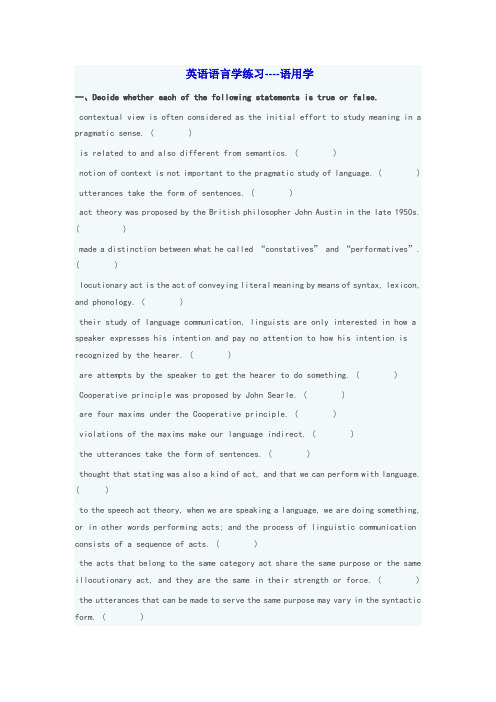
英语语言学练习----语用学一、Decide whether each of the following statements is true or false.contextual view is often considered as the initial effort to study meaning in a pragmatic sense. ( )is related to and also different from semantics. ( )notion of context is not important to the pragmatic study of language. ( ) utterances take the form of sentences. ( )act theory was proposed by the British philosopher John Austin in the late 1950s. ( )made a distinction between what he called “constatives” and “performatives”. ( )locutionary act is the act of conveying literal meaning by means of syntax, lexicon, and phonology. ( )their study of language communication, linguists are only interested in how a speaker expresses his intention and pay no attention to how his intention is recognized by the hearer. ( )are attempts by the speaker to get the hearer to do something. ( )Cooperative principle was proposed by John Searle. ( )are four maxims under the Cooperative principle. ( )violations of the maxims make our language indirect. ( )the utterances take the form of sentences. ( )thought that stating was also a kind of act, and that we can perform with language. ( )to the speech act theory, when we are speaking a language, we are doing something, or in other words performing acts; and the process of linguistic communication consists of a sequence of acts. ( )the acts that belong to the same category act share the same purpose or the same illocutionary act, and they are the same in their strength or force. ( ) the utterances that can be made to serve the same purpose may vary in the syntactic form. ( )participants nearly always observe the CP and the maxims of the CP. ( ) sentence is grammatical concept, and the meaning of a sentence is often studied as the abstract intrinsic property of the sentence itself in terms of a predication. ( )is based on sentence meaning, it is the realization of the abstract meaning of a sentence in a real situation of communication or simply in a context. ( ) the process of communication is essentially a process of conveying meaning in a certain context, pragmatics can also be regarded as a kind of meaning study. ( )linguists found that it would be impossible to give an adequate description of meaning if the context of language use was left considered.essentially distinguishes semantics and pragmatics is whether in the study of meaning the context of use is considered. ( )the shared knowledge both by the speaker and the hearer, linguistic communication would not be possible, and without considering such knowledge, linguistic communication cannot be satisfactorily accounted for in a semantic sense. ( ) perlocutionary act is the act of expressing the speaker’s intention. () to Paul Grice’s idea, in making conversation, the participants must first of all be willing to cooperate, otherwise, it would not be possible for them to carry on the talk. ( )illocutionary act is the consequence of or the change brought about by the utterance.【Keys】:1. T2. T11. T 16. F 17. T21. T 26. T 27. F二、Fill each of following blanks with one word which begins with the letter given.1. The shared knowledge which constitutes context is of two types; the knowledge of the l________ they use, and the knowledge about the w_______, including the general knowledge about the world and specific knowledge about the situation in which linguistic communication is taking place.2. If we think of a sentence as what people actually utter in the course of communication, it becomes an u________, and it should be considered in the situation in which it is actually used.3. The idea of Paul Grice is that in making conversation, the participants must first of all be willing to c_______, otherwise, it would be impossible for them to carry on the talk. The general principle is called the c________ p_________, abbreviated as CP.4. There are four maxims under the CP: the maxim of quantity, the maxim of q_________, the maxim of relation and the maxim of m____________.5. The maxim of relation requires that what the conversation participants say must be r__________.6. As the process of communication is essentially a process of conveying meaning in a certain context, p__________ can be regarded as a kind of meaning study.7. If c___________ is not considered, the study of meaning is restricted to the area of traditional semantics.8. The meaning of an u__________ is concrete and context-dependent.9. An i___________ act is the act of expressing the speaker’s intention.10. According to Seale, s__________acts fall into five general categories.11. C__________ are those speech acts whose point is to commit the speaker to some future course of action.12. To ask someone to pass a book is obviously a d__________.13. According to Paul Grice, in making c__________ the participants must first of all be willing to cooperate.14. Most of the violations of the four maxims give rise to c___________ implicatures.15. The significance of Grice’s c___________ principle lies in that it explains how it is possible for the speaker to convey more than is literally said.【Keys】:1. language, word2. utterance3. cooperate, Cooperative Principle4. quality, mannar5.relevant6. pragmatics7. context8. utterance9. illocutionary 10. speech 11.Commissive 12. dirextive 13. conversation 14. conversational15. Cooperative三、There are four choices following each statement. Mark the choice that can best complete the statement.1. __________ resulted mainly from the eapansion of the study of linguistics, especially that of semantics.A. PragmaticsB. PragmatismC. PhonologyD. Practicalism2. Once the notion of _________ was taken into consideration, semantics spiiled into pragmatics.A. meaningB. contextC. formD. content3. If a sentence is regarded as what people actually utter in the course of communication, it becomes _______.A. a sentenceB. an actC. a unitD. an utterance4. A ___________ analysis of an utterance will reveal what the speaker intends to do with it.A. semanticB. syntacticC. pragmaticD. grammatical5. _______ act theory is an important theory in the pragmatic study of language.A. SpeakingB. SpeechC. SoundD. Spoken6. ______ act is the act performed by or resulting from saying something.A. A locutionaryB. An illocutionaryC. A perlocutionaryD. A speech7. One of the contributions Searle has made is his classification of __________ acts.A. locutionaryB. illocutionaryC. perlocutionaryD. speech8. The illocutionary point of __________ is to express the psychological state specified in the utterance.A. directivesB. commisivesC. expressivesD. declarations9. All the utterance that can be made to serve the same purpose may vary in their _________ form.A. syntacticB. semanticC. grammaticalD. pragmatic10. The cooperative Principle is proposed by ________.A. John SearleB. John AustinC. Paul GriceD. John Lyons11. Linguists found that it would be impossible to give an adequate description of meaning if the ________ of language use was left unconsidered.A. brevityB. contextC. accuracyD. none of the above12. Of the three speech acts, linguistic are most interested in the _________.A. locutionary actB. perlocutionary actC. illocutionary actD. none of the above13. The maxim of quantity requires: ___________.A. make your contribution ad informative as required.B. Do not make contribution more informative than is required.C. Do not say that for which you lack adequate evidence.D. Both A and B.14. The maxim of quality requireds: do not say what you believe to be ________.A. falseB. trueC. briefD. orderly15. Most of the violations of the maxims of the CP give rise to _______.A. utterance meaningB. speech act theoryC. conversational implicaturesD. all of the above.16. The significance of Grice’s CP lies in that it explains how it is possible for the speaker to convey _________ is literally said.A. more thanB. less thanC. the same asD. none of the above.【Keys】:1. A2. B3. D4. C5. B6. C7.B 8.C 9. A 10. C 11. B 12. C 13.D 14. A 15. C 16. A四、Define the following terms.1. context2. utterance meaning3. locutionary act4. illocutionary act5. perlocutionary act【Keys】:1. Context is regarded as constituted by all kinds of knowledge assumed to be shared by the speaker and the hearer.2. Utterance meaning is the realization of the abstract meaning of a sentence ina real situation of communication, or simply in a context; it is concrete and dependent on the context.3. A locutionary act is the act of uttering words, phrases, and clauses. It is the act of conveying literal meaning by means of syntax, lexicon and phonology.4. An ill ocutionary act is the act of expressing the speaker’s intention; it is the act performed in saying something.5. A perlocuionary act is the act performed or resulting from saying something; it is the consequence of, or resulting saying something.。
英语专业(语言学)历年真题试卷汇编2

英语专业(语言学)历年真题试卷汇编2(总分:50.00,做题时间:90分钟)一、填空题(总题数:25,分数:50.00)1.Human language is arbitrary. This refers to the fact that there is no logical or intrinsic connection between a particular sound and the 1it is associated with.(人大2007研)(分数:2.00)填空项1:__________________ (正确答案:正确答案:meaning)解析:解析:(语言具有任意性,其所指与其形式没有逻辑或内在的联系。
)2.Human languages enable their users to symbolize objects, events and concepts which are not present(in time and space)at the moment of communication. This quality is labeled as 1.(北二外2003研)(分数:2.00)填空项1:__________________ (正确答案:正确答案:displacement)解析:解析:(移位性是指人类语言可以让使用者在交际时用语言符号代表时间和空间上不可及的物体、事件和观点。
)3.By duality is meant the property of having two levels of structures,such that units of the 1level are composed of elements of the 2level and each of the two levels has its own principles of organization.(北二外2006研)(分数:2.00)填空项1:__________________ (正确答案:正确答案:primary)填空项1:__________________ (正确答案:secondary)解析:解析:(双重性是指拥有两层结构的这种属性,底层结构是上层结构的组成成分,每层都有自身的组合规则。
英语专业(语言学)历年真题试卷汇编19
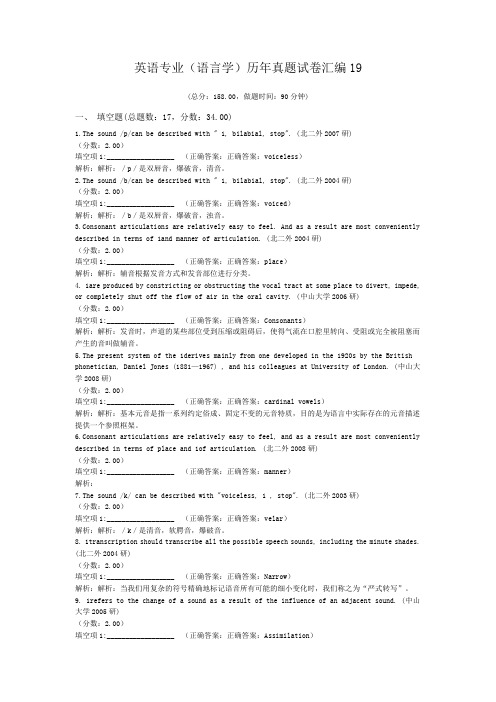
英语专业(语言学)历年真题试卷汇编19(总分:158.00,做题时间:90分钟)一、填空题(总题数:17,分数:34.00)1.The sound /p/can be described with " 1, bilabial, stop". (北二外2007研)(分数:2.00)填空项1:__________________ (正确答案:正确答案:voiceless)解析:解析:/p/是双唇音,爆破音,清音。
2.The sound /b/can be described with " 1, bilabial, stop". (北二外2004研)(分数:2.00)填空项1:__________________ (正确答案:正确答案:voiced)解析:解析:/b/是双唇音,爆破音,浊音。
3.Consonant articulations are relatively easy to feel. And as a result are most conveniently described in terms of 1and manner of articulation. (北二外2004研)(分数:2.00)填空项1:__________________ (正确答案:正确答案:place)解析:解析:辅音根据发音方式和发音部位进行分类。
4. 1are produced by constricting or obstructing the vocal tract at some place to divert, impede, or completely shut off the flow of air in the oral cavity. (中山大学2006研)(分数:2.00)填空项1:__________________ (正确答案:正确答案:Consonants)解析:解析:发音时,声道的某些部位受到压缩或阻碍后,使得气流在口腔里转向、受阻或完全被阻塞而产生的音叫做辅音。
英语专业(语言学)历年真题试卷汇编3
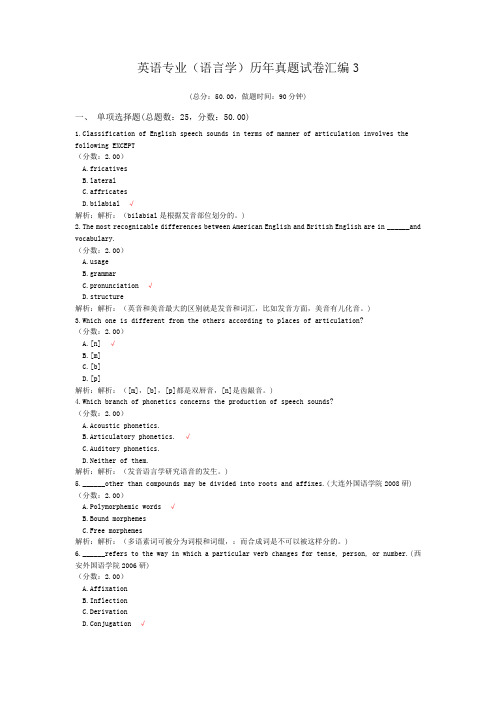
英语专业(语言学)历年真题试卷汇编3(总分:50.00,做题时间:90分钟)一、单项选择题(总题数:25,分数:50.00)1.Classification of English speech sounds in terms of manner of articulation involves the following EXCEPT(分数:2.00)A.fricativesteralC.affricatesD.bilabial √解析:解析:(bilabial是根据发音部位划分的。
)2.The most recognizable differences between American English and British English are in ______and vocabulary.(分数:2.00)ageB.grammarC.pronunciation √D.structure解析:解析:(英音和美音最大的区别就是发音和词汇,比如发音方面,美音有儿化音。
)3.Which one is different from the others according to places of articulation?(分数:2.00)A.[n] √B.[m]C.[b]D.[p]解析:解析:([m],[b],[p]都是双唇音,[n]是齿龈音。
)4.Which branch of phonetics concerns the production of speech sounds?(分数:2.00)A.Acoustic phonetics.B.Articulatory phonetics. √C.Auditory phonetics.D.Neither of them.解析:解析:(发音语言学研究语音的发生。
)5.______other than compounds may be divided into roots and affixes.(大连外国语学院2008研) (分数:2.00)A.Polymorphemic words √B.Bound morphemesC.Free morphemes解析:解析:(多语素词可被分为词根和词缀,:而合成词是不可以被这样分的。
专业英语八级英语语言学知识(语用学)模拟试卷1(题后含答案及解析)
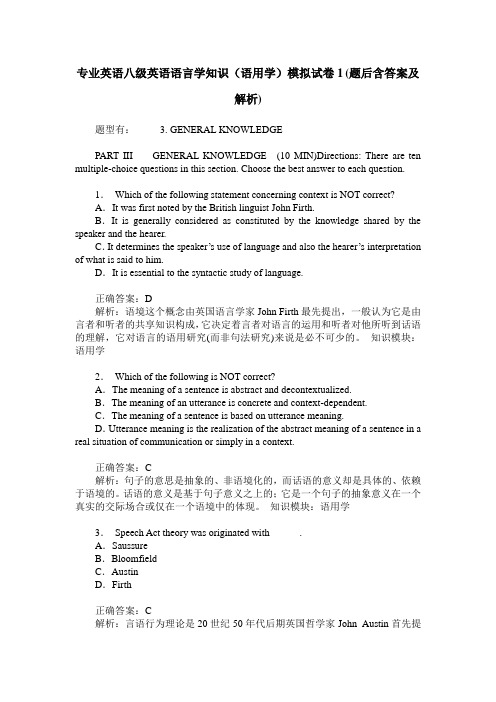
专业英语八级英语语言学知识(语用学)模拟试卷1(题后含答案及解析)题型有: 3. GENERAL KNOWLEDGEPART III GENERAL KNOWLEDGE (10 MIN)Directions: There are ten multiple-choice questions in this section. Choose the best answer to each question.1.Which of the following statement concerning context is NOT correct?A.It was first noted by the British linguist John Firth.B.It is generally considered as constituted by the knowledge shared by the speaker and the hearer.C.It determines the speaker’s use of language and also the hearer’s interpretation of what is said to him.D.It is essential to the syntactic study of language.正确答案:D解析:语境这个概念由英国语言学家John Firth最先提出,一般认为它是由言者和听者的共享知识构成,它决定着言者对语言的运用和听者对他所听到话语的理解,它对语言的语用研究(而非句法研究)来说是必不可少的。
知识模块:语用学2.Which of the following is NOT correct?A.The meaning of a sentence is abstract and decontextualized.B.The meaning of an utterance is concrete and context-dependent.C.The meaning of a sentence is based on utterance meaning.D.Utterance meaning is the realization of the abstract meaning of a sentence in a real situation of communication or simply in a context.正确答案:C解析:句子的意思是抽象的、非语境化的,而话语的意义却是具体的、依赖于语境的。
英语语言学试题及答案
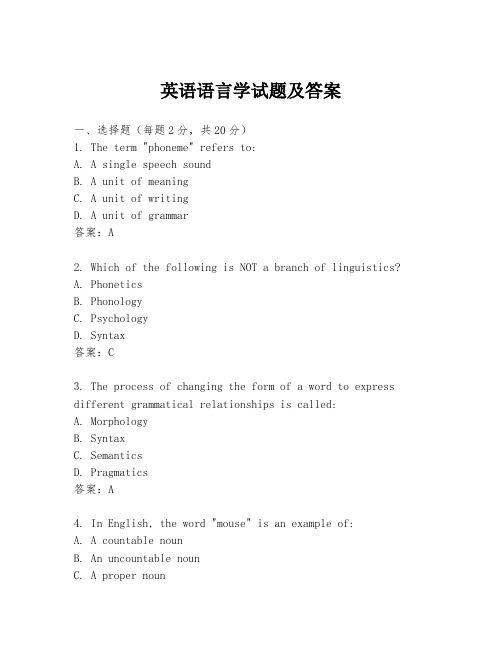
英语语言学试题及答案一、选择题(每题2分,共20分)1. The term "phoneme" refers to:A. A single speech soundB. A unit of meaningC. A unit of writingD. A unit of grammar答案:A2. Which of the following is NOT a branch of linguistics?A. PhoneticsB. PhonologyC. PsychologyD. Syntax答案:C3. The process of changing the form of a word to express different grammatical relationships is called:A. MorphologyB. SyntaxC. SemanticsD. Pragmatics答案:A4. In English, the word "mouse" is an example of:A. A countable nounB. An uncountable nounC. A proper nounD. An article答案:A5. The study of meaning in language is known as:A. SemanticsB. PragmaticsC. SyntaxD. Phonology答案:A6. The smallest unit of sound that can distinguish meaning ina language is called:A. PhonemeB. MorphemeC. SyllableD. Word答案:A7. The branch of linguistics that studies the social aspects of language is:A. SociolinguisticsB. PsycholinguisticsC. NeurolinguisticsD. Computational linguistics答案:A8. The use of language in context is studied in:A. SemanticsB. PragmaticsC. SyntaxD. Phonology答案:B9. The process of acquiring a first language is known as:A. Second language acquisitionB. Foreign language learningC. Language learningD. First language acquisition答案:D10. The systematic arrangement of words and phrases to create well-formed sentences is the study of:A. PhonologyB. SyntaxC. SemanticsD. Pragmatics答案:B二、填空题(每题2分,共20分)1. The study of speech sounds is called ____________.答案:Phonetics2. The smallest meaningful unit of language is known as a____________.答案:Morpheme3. The branch of linguistics that deals with the structure of words is ____________.答案:Morphology4. The study of how language is used in social contexts is called ____________.答案:Sociolinguistics5. The process by which children acquire their first language is known as ____________.答案:Language acquisition6. The study of the rules governing the formation of sentences in a language is ____________.答案:Syntax7. The branch of linguistics that examines the psychological aspects of language is ____________.答案:Psycholinguistics8. The study of the meanings of words, phrases, and sentences is known as ____________.答案:Semantics9. The branch of linguistics concerned with the relationship between language and culture is ____________.答案:Anthropological linguistics10. The study of how language is processed in the brain is called ____________.答案:Neurolinguistics三、简答题(每题10分,共30分)1. Explain the difference between a phoneme and an allophone. 答案:A phoneme is the smallest unit of sound that can distinguish meaning in a language, while an allophone is a variant of a phoneme that does not change the meaning of aword.2. What is the role of syntax in language?答案:Syntax is the set of rules, principles, and processes that govern the structure of sentences in a language,including how words and phrases are arranged to create well-formed sentences.3. How does sociolinguistics contribute to our understandingof language?答案:Sociolinguistics helps us understand how languagevaries according to social factors such as class, gender, age, and ethnicity, and how these variations affect communication and social interaction.四、论述题(每题15分,共30分)1. Discuss the importance of pragmatics in language communication.答案:Pragmatics is crucial in language communication as it deals with the way context influences the interpretation of meaning. It helps us understand how speakers convey intended meanings beyond the literal interpretation of words and sentences, taking into account factors such as tone, body language, and shared knowledge.2. Explain the concept of language universals and give examples.答案:Language universals refer to the structural and functional features that are common to all human languages. Examples include the presence of nouns and verbs, the use ofword order to convey meaning, and the ability to form questions and negations.。
英语专业(语言学)历年真题试卷汇编25

英语专业(语言学)历年真题试卷汇编25(总分:72.00,做题时间:90分钟)一、填空题(总题数:5,分数:10.00)1.There has been a maxim in 1which claims that "You are what you say". (中山大学2008研)(分数:2.00)填空项1:__________________ (正确答案:正确答案:quantity)解析:解析:格莱斯的数量准则指1.使你的话语如(交谈的当前目的)所要求的那样信息充分;2.不要使你的话语比要求的信息更充分。
即说你该说的。
2.The theory of conversational implicature was proposed by 1. (中山大学2008研)(分数:2.00)填空项1:__________________ (正确答案:正确答案:Grice)解析:解析:格赖斯认为一定存在一些管理话语产生和理解的机制。
他把这种机制称为合作原则,在这个大原则下有四条准则,它们分别为数量、质量、关系和方式准则。
3. 1were sentences that did not state a fact or describe a state, and were not verifiable. (分数:2.00)填空项1:__________________ (正确答案:正确答案:Performatives)解析:解析:施为句是用来做事的,既不陈述事实,也不描述情况,且不能验证其真假。
4.In making conversation, the general principle that all participants are expected to observe is called the 1principle proposed by J. Grice.(分数:2.00)填空项1:__________________ (正确答案:正确答案:Cooperative)解析:解析:通常在对话中,所有的参与者都被希望能够遵守由格莱斯提出的合作原则,这样就不会有会话含义的产生。
(完整word)语用学试题
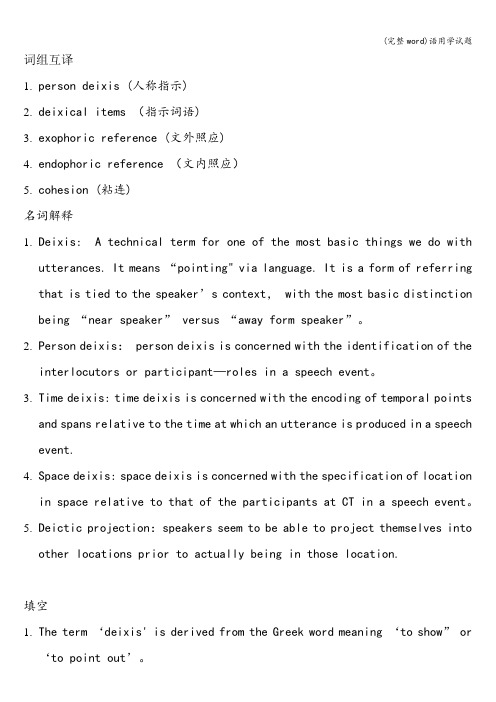
词组互译1.person deixis (人称指示)2.deixical items (指示词语)3.exophoric reference (文外照应)4.endophoric reference (文内照应)5.cohesion (粘连)名词解释1.Deixis: A technical term for one of the most basic things we do withutterances. It means “pointing" via language. It is a form of r eferring that is tied to the speaker’s context, with the most basic distinction being “near speaker” versus “away form speaker”。
2.Person deixis: person deixis is concerned with the identification of theinterlocutors or participant—roles in a speech event。
3.Time deixis: time deixis is concerned with the encoding of temporal pointsand spans relative to the time at which an utterance is produced in a speech event.4.Space deixis: space deixis is concerned with the specification of locationin space relative to that of the participants at CT in a speech event。
- 1、下载文档前请自行甄别文档内容的完整性,平台不提供额外的编辑、内容补充、找答案等附加服务。
- 2、"仅部分预览"的文档,不可在线预览部分如存在完整性等问题,可反馈申请退款(可完整预览的文档不适用该条件!)。
- 3、如文档侵犯您的权益,请联系客服反馈,我们会尽快为您处理(人工客服工作时间:9:00-18:30)。
英语语言学练习----语用学一、Decide whether each of the following statements is true or false.1.The contextual view is often considered as the initial effort to study meaning in a pragmatic sense. ( )2.Pragmatics is related to and also different from semantics. ( )3.The notion of context is not important to the pragmatic study of language. ( )4.All utterances take the form of sentences. ( )5.Speech act theory was proposed by the British philosopher John Austin in the late 1950s. ( )6.Grice made a distinction between what he called “constatives” and “performatives”. ()7.A locutionary act is the act of conveying literal meaning by means of syntax, lexicon, and phonology. ( )8.In their study of language communication, linguists are only interested in howa speaker expresses his intention and pay no attention to how his intention is recognized by the hearer. ( )9.Directives are attempts by the speaker to get the hearer to do something. ( )10.The Cooperative principle was proposed by John Searle. ( )11.There are four maxims under the Cooperative principle. ( )12.The violations of the maxims make our language indirect. ( )13.All the utterances take the form of sentences. ( )14.Austin thought that stating was also a kind of act, and that we can perform with language. ( )15.According to the speech act theory, when we are speaking a language, we are doing something, or in other words performing acts; and the process of linguistic communication consists of a sequence of acts. ( )16.All the acts that belong to the same category act share the same purpose or the same illocutionary act, and they are the same in their strength or force. ( ) 17.All the utterances that can be made to serve the same purpose may vary in the syntactic form. ( )18.Conversation participants nearly always observe the CP and the maxims of the CP. ( )19.A sentence is grammatical concept, and the meaning of a sentence is often studied as the abstract intrinsic property of the sentence itself in terms of a predication. ( )20.Utterance is based on sentence meaning, it is the realization of the abstract meaning of a sentence in a real situation of communication or simply in a context. ( )21.As the process of communication is essentially a process of conveying meaning in a certain context, pragmatics can also be regarded as a kind of meaning study. ( )22.Gradually linguists found that it would be impossible to give an adequate description of meaning if the context of language use was left considered.23.What essentially distinguishes semantics and pragmatics is whether in the study of meaning the context of use is considered. ( )24.Without the shared knowledge both by the speaker and the hearer, linguistic communication would not be possible, and without considering such knowledge, linguistic communication cannot be satisfactorily accounted for in a semantic sense. ( )25.An perlocutionary act is the act of expressing the speaker’s intention. ( )26.According to Paul Grice’s idea, in making conversation, the participants must first of all be willing to cooperate, otherwise, it would not be possible for them to carry on the talk. ( )27.An illocutionary act is the consequence of or the change brought about by the utterance.【Keys】:1. T2.T 3.F 4.F 5.T 6.F 7.T 8.F 9.T10.F11. T 12.T 13.F 14.T 15.T 16. F 17.T 18.F 19.T 20.T21. T 22.F 23.T 24.F 25.F 26. T 27. F二、Fill each of following blanks with one word which begins with the letter given.1. The shared knowledge which constitutes context is of two types; the knowledge of the l________ they use, and the knowledge about the w_______, including the general knowledge about the world and specific knowledge about the situation in which linguistic communication is taking place.2. If we think of a sentence as what people actually utter in the course of communication, it becomes an u________, and it should be considered in the situation in which it is actually used.3. The idea of Paul Grice is that in making conversation, the participants must first of all be willing to c_______, otherwise, it would be impossible for them to carry on the talk. The general principle is called the c________ p_________, abbreviated as CP.4. There are four maxims under the CP: the maxim of quantity, the maxim of q_________, the maxim of relation and the maxim of m____________.5. The maxim of relation requires that what the conversation participants say must be r__________.6. As the process of communication is essentially a process of conveying meaning in a certain context, p__________ can be regarded as a kind of meaning study.7. If c___________ is not considered, the study of meaning is restricted to the area of traditional semantics.8. The meaning of an u__________ is concrete and context-dependent.9. An i___________ act is the act of expressing the speaker’s intention.10. According to Seale, s__________acts fall into five general categories.11. C__________ are those speech acts whose point is to commit the speaker to some future course of action.12. To ask someone to pass a book is obviously a d__________.13. According to Paul Grice, in making c__________ the participants must first of all be willing to cooperate.14. Most of the violations of the four maxims give rise to c___________ implicatures.15. The significance of Grice’s c___________ principle lies in that it explains how it is possible for the speaker to convey more than is literally said.【Keys】:1. language, word2. utterance3. cooperate, Cooperative Principle4. quality, mannar5.relevant6. pragmatics7. context8. utterance9. illocutionary 10. speech 11.Commissive 12. dirextive 13. conversation 14. conversational15. Cooperative三、There are four choices following each statement. Mark the choice that can best complete the statement.1. __________ resulted mainly from the eapansion of the study of linguistics, especially that of semantics.A. PragmaticsB. PragmatismC. PhonologyD. Practicalism2. Once the notion of _________ was taken into consideration, semantics spiiled into pragmatics.A. meaningB. contextC. formD. content3. If a sentence is regarded as what people actually utter in the course of communication, it becomes _______.A. a sentenceB. an actC. a unitD. an utterance4. A ___________ analysis of an utterance will reveal what the speaker intends to do with it.A. semanticB. syntacticC. pragmaticD. grammatical5. _______ act theory is an important theory in the pragmatic study of language.A. SpeakingB. SpeechC. SoundD. Spoken6. ______ act is the act performed by or resulting from saying something.A. A locutionaryB. An illocutionaryC. A perlocutionaryD. A speech7. One of the contributions Searle has made is his classification of __________ acts.A. locutionaryB. illocutionaryC. perlocutionaryD. speech8. The illocutionary point of __________ is to express the psychological state specified in the utterance.A. directivesB. commisivesC. expressivesD. declarations9. All the utterance that can be made to serve the same purpose may vary in their _________ form.A. syntacticB. semanticC. grammaticalD. pragmatic10. The cooperative Principle is proposed by ________.A. John SearleB. John AustinC. Paul GriceD. John Lyons11. Linguists found that it would be impossible to give an adequate description of meaning if the ________ of language use was left unconsidered.A. brevityB. contextC. accuracyD. none of the above12. Of the three speech acts, linguistic are most interested in the _________.A. locutionary actB. perlocutionary actC. illocutionary actD. none of the above13. The maxim of quantity requires: ___________.A. make your contribution ad informative as required.B. Do not make contribution more informative than is required.C. Do not say that for which you lack adequate evidence.D. Both A and B.14. The maxim of quality requireds: do not say what you believe to be ________.A. falseB. trueC. briefD. orderly15. Most of the violations of the maxims of the CP give rise to _______.A. utterance meaningB. speech act theoryC. conversational implicaturesD. all of the above.16. The significance of Grice’s CP lies in that it explains how it is possible for the speaker to convey _________ is literally said.A. more thanB. less thanC. the same asD. none of the above.【Keys】:1. A2. B3. D4. C5. B6. C7.B 8.C 9. A 10. C 11. B 12. C 13.D 14. A 15. C 16. A四、Define the following terms.1. context2. utterance meaning3. locutionary act4. illocutionary act5. perlocutionary act【Keys】:1. Context is regarded as constituted by all kinds of knowledge assumed to be shared by the speaker and the hearer.2. Utterance meaning is the realization of the abstract meaning of a sentence ina real situation of communication, or simply in a context; it is concrete and dependent on the context.3. A locutionary act is the act of uttering words, phrases, and clauses. It is the act of conveying literal meaning by means of syntax, lexicon and phonology.4. An illocutionary act is the act of expressing the speaker’s intention; it is the act performed in saying something.5. A perlocuionary act is the act performed or resulting from saying something; it is the consequence of, or resulting saying something.(注:文档可能无法思考全面,请浏览后下载,供参考。
